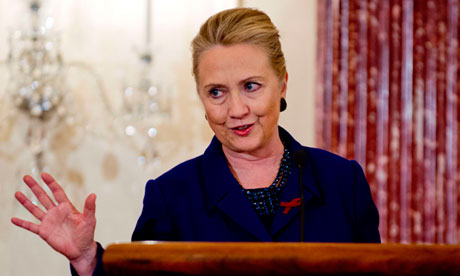
A five-point plan for ending the Aids pandemic has been unveiled by the US secretary of state, Hillary Clinton, who said the Obama administration would focus efforts on women and girls but also the stigmatised communities most affected by HIV – drug users, sex workers and men who have sex with men.
"Make no mistake about it – HIV may well be with us into the future, but the disease that it causes need not be," said Clinton at the launch of the so-called Blueprint at the state department in Washington before World Aids Day on Saturday.
Advances in science and technology have now made it possible for the next generation to be Aids free, said Clinton. Babies need not be born with HIV infection as drug regimes can prevent transmission of the virus from the mother at birth, and adults with HIV can receive treatment which keeps them well and stops them infecting their partners. Progress is also being made on developing microbicides and vaccines which will protect healthy people from infection.
A report from UNAids last week showed that over the past decade, the rate of new infections had dropped by more than half in 25 low and middle-income countries, including Zimbabwe with a drop of 50% and Malawi with a drop of 73%. "As we continue to drive down the number of new infections and drive up the number of people on treatment, eventually we will be able to treat more people than become infected every year. That will be the tipping point. We will then get ahead of the pandemic and an Aids-free generation will be in our sight," said Clinton.
The Blueprint will:
• Rapidly scale up the most effective treatment and prevention interventions. That will include getting more people on antiretroviral drugs which keep them not only healthy but less infectious. The US president's emergency plan for Aids relief (Pepfar) has already funded drugs for 5.1 million people out of the total of more than 8 million on treatment worldwide – a 200% increase since 2008.
• Focus efforts where the virus is, targeting populations at greatest risk and who suffer most from stigma: those who inject drugs, sex workers as well as those trafficked into prostitution and men who have sex with men. It will also focus more intently on women and girls who are put at risk through gender discrimination and violence, integrating HIV programmes with family planning and reproductive health.
• Promote sustainability and effectiveness – for example, Pepfar has saved billions of dollars by buying generic instead of brand-name HIV drugs, said Clinton.
• Encourage affected countries to step up efforts to protect and help their own communities and urge donors to meet their funding commitments.
• Support research into new scientific advances and innovative approaches. "It is science that has brought us to this point. It is science that will allow us to finish the job," said Clinton.
The secretary of state called on Eric Goosby, the US global Aids co-ordinator, to produce the Blueprint at the International Aids Conference in Washington DC in July, when she pledged that the Obama administration would do whatever it took to end the HIV epidemic. She told the 25,000-strong conference: "I'm here to make it absolutely clear that the US is committed and will remain committed to achieving an Aids-free generation. We will not back off and we will not back down. We will fight for the resources necessary to achieve this historic milestone."

